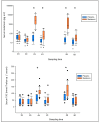Melatonin Pharmacological Blood Levels Increase Total Antioxidant Capacity in Critically Ill Patients
- PMID: 28368352
- PMCID: PMC5412344
- DOI: 10.3390/ijms18040759
Melatonin Pharmacological Blood Levels Increase Total Antioxidant Capacity in Critically Ill Patients
Abstract
In this study, the aim was to test the biochemical effects of melatonin supplementation in Intensive Care Unit (ICU) patients, since their blood levels are decreased. Sixty-four patients were enrolled in the study. From the evening of the 3rd ICU day, patients were randomized to receive oral melatonin (3 mg, group M) or placebo (group P) twice daily, at 20:00 and 24:00, until discharged. Blood was taken (at 00:00 and 14:00), on the 3rd ICU day to assess basal nocturnal melatonin values, and then during the treatment period on the 4th and 8th ICU days. Melatonin, total antioxidant capacity, and oxidative stress were evaluated in serum. Melatonin circadian rhythm before treatment was similar in the two groups, with a partial preservation of the cycle. Four hours from the 1st administration (4th ICU day, 00:00), melatonin levels increased to 2514 (982.3; 7148) pg·mL-1 in group M vs. 20.3 (14.7; 62.3) pg·mL-1 in group P (p < 0.001). After five treatment days (8th ICU day), melatonin absorption showed a repetitive trend in group M, while in group P nocturnal secretion (00:00) was impaired: 20 (11.5; 34.5) pg·mL-1 vs. 33.8 (25.0; 62.2) on the 3rd day (p = 0.029). Immediately from the beginning of treatment, the total antioxidant capacity was significantly higher in melatonin treated subjects at 00:00; a significant correlation was found between total antioxidant capacity and blood melatonin values (ρ = 0.328; p < 0.001). The proposed enteral administration protocol was adequate, even in the early phase, to enhance melatonin blood levels and to protect the patients from oxidative stress. The antioxidant effect of melatonin could play a meaningful role in the care and well-being of these patients.
Keywords: antioxidants; critical illness; dietary supplements; melatonin; oxidative stress.
Conflict of interest statement
The authors declare no conflict of interest.
Figures






References
Publication types
MeSH terms
Substances
LinkOut - more resources
Full Text Sources
Other Literature Sources
Medical

